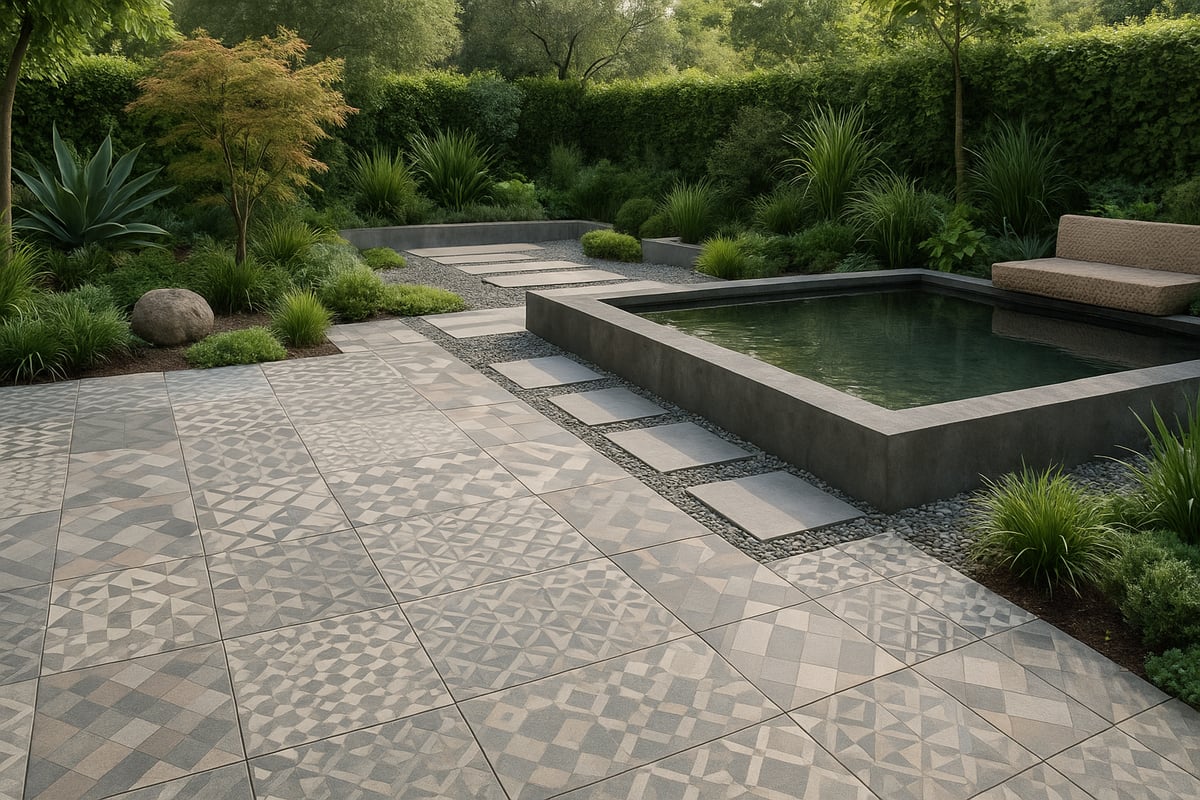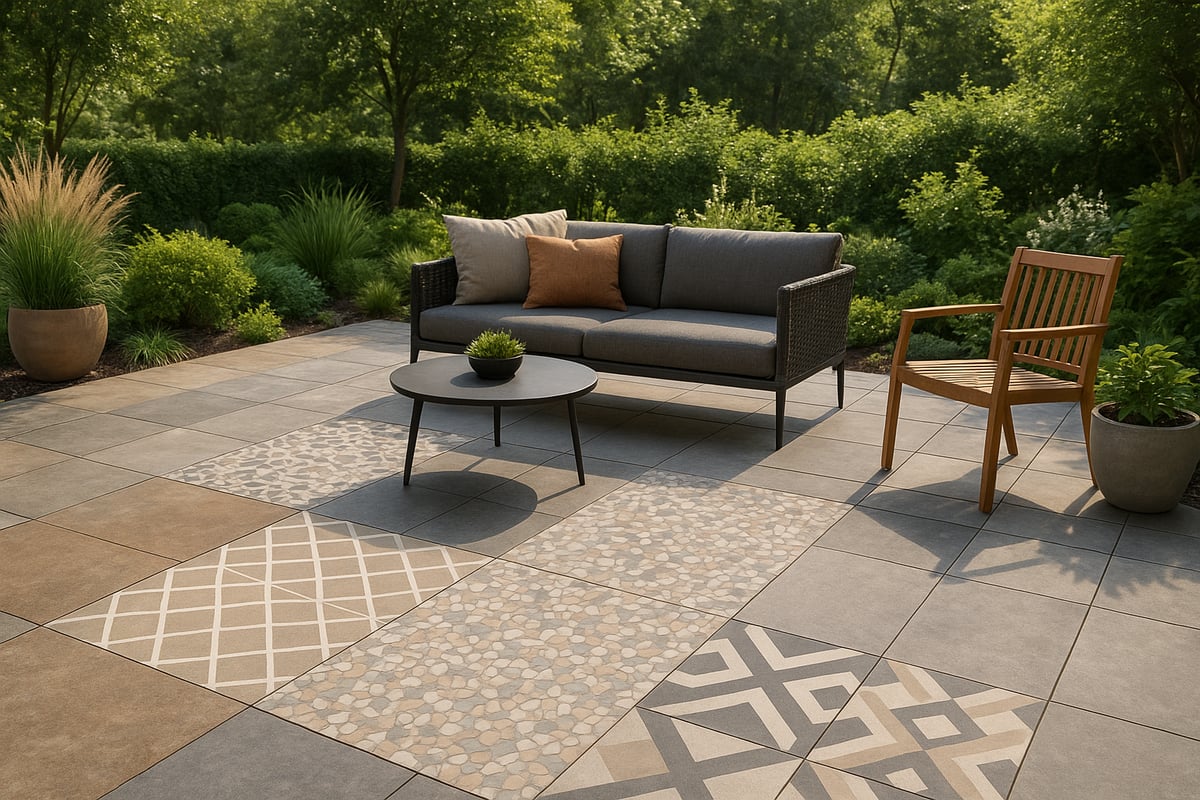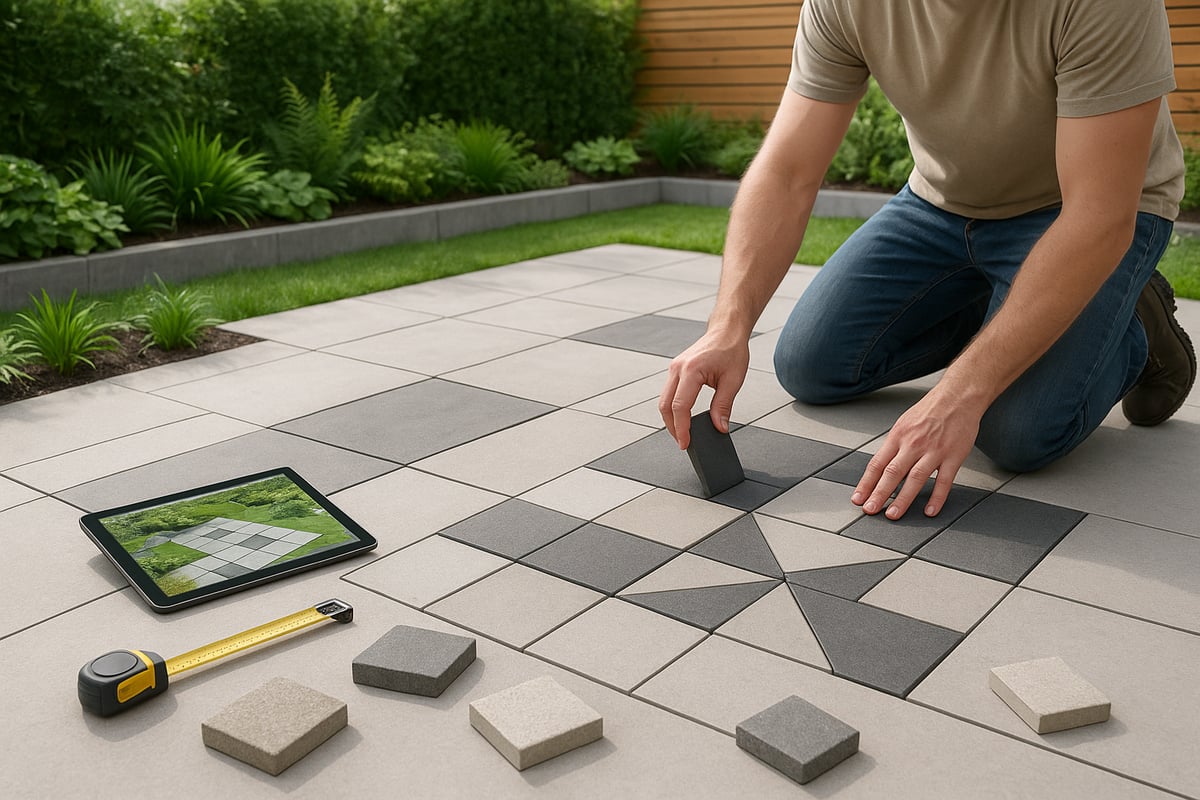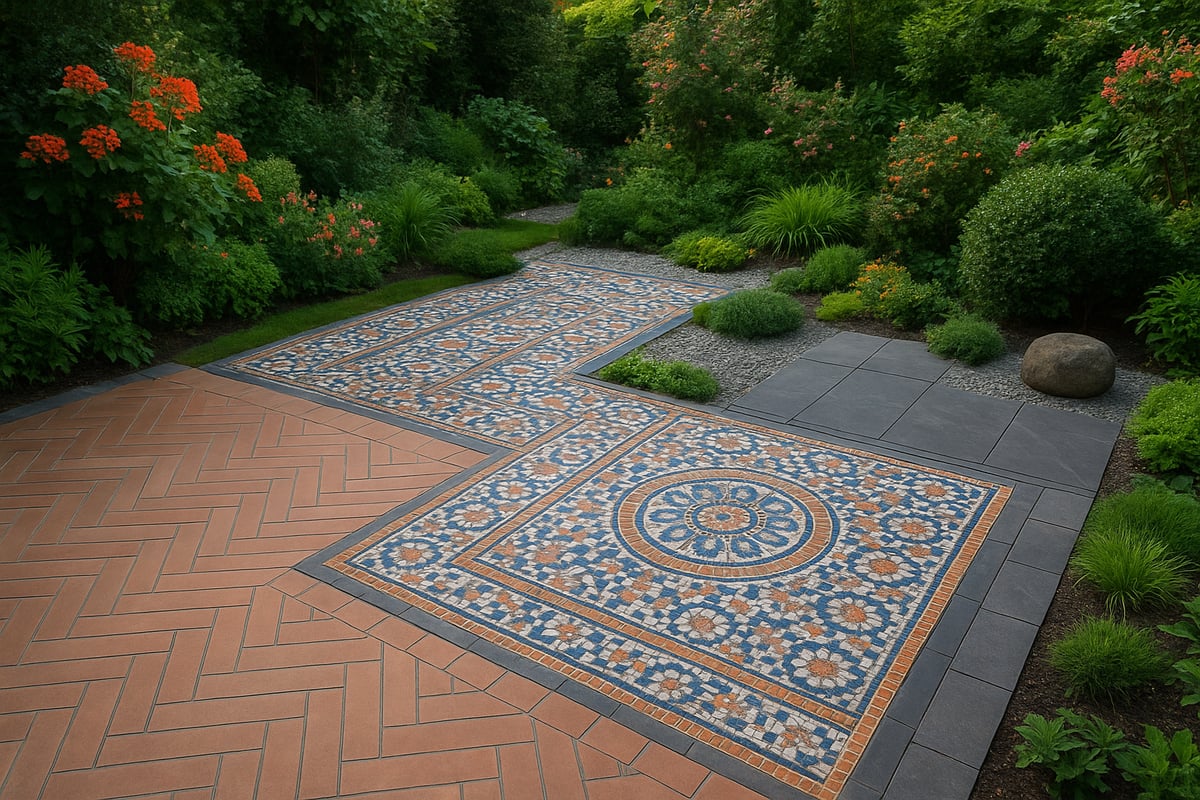Are you ready to elevate your outdoor sanctuary with a modern garden tiles pattern? The world of outdoor design is buzzing as homeowners and designers look for creative, personalized solutions. In this guide, you will explore the freshest trends, innovative ideas, and step-by-step strategies to design a garden tiles pattern that blends style with practical function.
Discover the most popular layouts, materials, and color palettes for 2025. Find expert installation tips and real design inspiration to help your garden stand out. Imagine a space that is both beautiful and uniquely yours.
Dive in and start planning your garden transformation for the new year.
The Rise of Garden Tile Patterns: Trends & Influences for 2025
Garden tiles pattern design has evolved from simple stone paths to a powerful tool for creating character and harmony in modern landscapes. Originally, tiles were used for practical walkways and patios, but today, their patterns define the mood and style of outdoor spaces.
Global design trends have played a significant role in shaping the garden tiles pattern. Mediterranean courtyards introduced vibrant mosaics, Moroccan gardens brought intricate geometric motifs, and Japanese landscapes inspired minimalist arrangements. Technology has enabled new manufacturing techniques, making it possible to create complex designs with sustainable materials, such as recycled porcelain and eco-friendly composites.
Sustainability is now a key influence. Homeowners are increasingly seeking garden tiles pattern options made from recycled materials or those certified for low environmental impact. The shift from traditional paving stones to modular, patterned tile systems reflects a desire for both beauty and environmental responsibility.

The Evolution of Garden Tiles
The story of garden tiles pattern design is one of constant reinvention. Ancient civilizations used terracotta and hand-painted tiles to create decorative courtyards. Over time, these patterns spread across continents, adapting to local materials and cultural aesthetics.
In recent decades, advances in digital printing and manufacturing have enabled the creation of intricate garden tiles pattern options not possible before. The influence of Mediterranean and Moroccan styles is evident in vibrant mosaics, while Japanese design encourages simplicity and subtle texture.
Sustainability is now at the forefront. Recycled glass, porcelain, and even reclaimed stone are being used in garden tiles pattern installations, blending eco-consciousness with visual appeal. The move from plain paving to modular systems allows for flexible, creative layouts that suit both small patios and expansive gardens.
2025 Pattern Trends: What’s Hot This Year
This year, garden tiles pattern design is all about creativity and personalization. Geometric layouts like chevron, herringbone, and hexagons are leading the way, offering movement and rhythm to outdoor spaces. Mosaic and patchwork influences bring eclectic flair, while large-format tiles provide a seamless, minimalist look for modern gardens.
Nature-inspired motifs are gaining popularity. Patterns featuring leaves, florals, and gentle wave designs echo the surrounding landscape and create a sense of tranquility. The indoor-outdoor living trend is also strong, with homeowners seeking to blur the line between exterior and interior by extending color palettes and tile styles across both areas.
Industry reports show a remarkable 30% increase in patterned tile sales for outdoor spaces in 2024, underscoring the growing demand for bold designs. In Toronto, rooftop gardens now feature striking geometric pavers, setting a new standard in urban garden tiles pattern applications. For more details on the latest styles, review the Top 2025 Tile Trends in Review.
Influential Designers and Projects
Leading landscape architects are setting trends in garden tiles pattern design. Their signature styles, often showcased at major design shows, combine traditional influences with modern innovation. Award-winning installations from international competitions highlight the versatility and beauty of patterned tiles in both public and private spaces.
Social media platforms like Instagram and Pinterest are amplifying these trends. Designers and homeowners share their unique garden tiles pattern creations, inspiring others to experiment with bold layouts, vibrant colors, and mixed materials. This digital exchange fuels rapid evolution in pattern popularity, ensuring that new ideas quickly become mainstream.
From celebrated professionals to enthusiastic DIYers, the world of garden tiles pattern is more dynamic and diverse than ever. As we move into 2025, expect even more creative collaborations and striking new projects inspired by global influences and cutting-edge technology.
Choosing the Right Garden Tile Pattern: Factors to Consider
Selecting the perfect garden tiles pattern requires a thoughtful approach. Every garden is unique, so your choices should reflect your space, lifestyle, and design goals. The following key factors will guide you in making informed decisions for a lasting and beautiful result.

Assessing Your Space and Needs
Begin by evaluating the size, shape, and layout of your outdoor area. A garden tiles pattern should enhance both functionality and style. For small urban patios, compact geometric arrangements can maximize the sense of space. In contrast, expansive suburban gardens may benefit from larger, sweeping patterns that define zones.
Consider how people move through your garden. Identify focal points such as seating areas, water features, or planters. Map out natural pathways to ensure your garden tiles pattern supports easy navigation and visual flow.
Pay attention to sunlight, shade, and drainage. Shady areas may need lighter tile colors to brighten the space, while well-drained zones are ideal for more porous materials. By matching the garden tiles pattern to your specific conditions, you’ll create a harmonious and practical outdoor retreat.
Material Matters: Tile Types and Their Impact
The choice of material plays a pivotal role in both the look and longevity of your garden tiles pattern. Popular options include porcelain, ceramic, natural stone, and composite tiles. Each offers distinct benefits and challenges.
| Material | Durability | Slip Resistance | Maintenance | Pattern Possibilities |
|---|---|---|---|---|
| Porcelain | High | Excellent | Low | Versatile |
| Ceramic | Moderate | Good | Moderate | Many |
| Natural Stone | High | Varies | High | Unique |
| Composite | Moderate | Good | Low | Modular |
Porcelain pavers, in particular, have surged in popularity for Canadian gardens due to their durability and low maintenance needs. For a deeper look at why porcelain is trending and how it can elevate your garden tiles pattern, explore Porcelain pavers for gardens.
Remember, the material you choose will affect installation methods, costs, and the potential for creative patterns. Always match your selection to your climate and usage needs.
Color, Texture, and Finish Selection
Color and texture are essential for setting the mood and ensuring safety in your garden tiles pattern. Earth tones, cool greys, and bold contrasts dominate the 2025 palette. Choose colors that complement your planting scheme and existing outdoor decor.
Textures matter for both aesthetics and function. Textured finishes provide extra grip, which is crucial for wet or high-traffic areas. Smooth tiles create a sleek, modern effect but may be slippery when wet. Matte finishes can reduce glare and enhance a natural look.
Coordinate your garden tiles pattern with furniture and plant choices. For example, a cool grey tile can highlight vibrant green foliage, while earth-toned tiles blend seamlessly with natural landscapes. The right combination of color and texture will make your garden inviting and safe.
Budget and Installation Considerations
Cost is a key factor when planning your garden tiles pattern. Material prices vary widely, with natural stone often being the most expensive and composite or ceramic tiles offering budget-friendly options. Installation complexity also influences the final cost.
Consider whether you prefer a DIY approach or professional installation. Modular tile systems are ideal for quick upgrades and easy installation, while intricate patterns or large-format tiles may require expert help. Factor in the cost of tools, base preparation, and potential repairs.
Compare typical costs:
- Porcelain: $$–$$$
- Ceramic: $–$$
- Natural Stone: $$$
- Composite: $–$$
Balancing your vision with your budget ensures your garden tiles pattern meets both aesthetic and financial expectations.
Sustainability and Eco-Friendly Choices
Sustainability is increasingly important in outdoor design. Opt for recycled materials or tiles manufactured with low environmental impact. Many garden tiles pattern options now feature permeable designs, allowing water to drain efficiently and supporting local ecosystems.
Look for certifications such as GreenGuard or LEED to confirm eco-friendly credentials. Permeable tile patterns also help manage rainwater runoff, which is vital for both sustainability and garden health.
Choosing sustainable materials not only benefits the planet but also adds long-term value to your garden tiles pattern. By prioritizing green options, you create a space that is both beautiful and responsible.
Step-by-Step: Planning and Installing Your Garden Tile Pattern
Transforming your outdoor space with a stunning garden tiles pattern requires careful planning and precise execution. By following this structured approach, you can ensure both beauty and durability for your new garden feature. Below, we break down the process into six essential steps, guiding you from creative vision to lasting installation.

Step 1: Inspiration and Visualization
Begin your garden tiles pattern journey by collecting ideas and visual references. Browse design magazines, online galleries, and showroom displays to discover what styles resonate with you. Digital tools and apps allow you to visualize different patterns and color schemes directly on images of your own garden.
Creating a mood board can help you organize your preferences and spot recurring themes. Consider how the garden tiles pattern will complement your existing landscaping and outdoor furniture. This step ensures your final design feels cohesive and tailored to your space.
Step 2: Measuring and Layout Design
Accurate measurements are the foundation of any successful garden tiles pattern project. Use a tape measure, graph paper, or digital layout tools to record the dimensions of your outdoor area. Map out potential tile layouts using string lines or specialized software, which can help you visualize how the pattern will flow.
Pay close attention to curved edges, existing garden features, and pathways. Adjust your garden tiles pattern to highlight focal points or guide movement through the space. Taking time with this step minimizes costly mistakes during installation.
Step 3: Selecting Materials and Ordering
Choosing the right materials is essential for both style and function. Decide between porcelain, ceramic, natural stone, or composite tiles, considering durability, slip resistance, and maintenance. Calculate the total number of tiles needed for your garden tiles pattern, always ordering extra to account for cuts and potential waste.
Research suppliers and understand lead times, especially if your chosen tiles are custom or imported. Modular tile kits can be a smart choice for quick, uniform installations, making this step more efficient for DIY projects.
Step 4: Preparing the Groundwork
Proper groundwork ensures your garden tiles pattern will stand the test of time. Start with a soil assessment to determine the right base, such as compacted gravel, sand, or a concrete slab. Prioritize drainage to prevent water pooling and frost damage.
Level the area carefully, using a spirit level and compactor for best results. Gather all necessary tools, including spades, rakes, and screeding bars. A well-prepared base supports the longevity and appearance of your garden tiles pattern.
Step 5: Tile Installation Techniques
With the groundwork ready, it's time to install your garden tiles pattern. Decide between dry-lay and mortar-set methods, based on your chosen materials and desired finish. Carefully cut tiles to fit edges and custom shapes, ensuring clean lines throughout the pattern.
Grouting and finishing are crucial for weather resistance and stability. For a detailed guide on installation, explore this step-by-step backyard tile flooring resource. Following best practices helps your garden tiles pattern achieve a professional look.
Step 6: Post-Installation Care
After installation, maintain your garden tiles pattern with regular cleaning and sealing. Use cleaners suitable for your tile material and seal porous surfaces to protect against stains and moisture. Inspect tiles seasonally, especially after winter, and replace any damaged pieces promptly.
Establish a maintenance routine that fits your climate and usage. With proper care, your garden tiles pattern will remain vibrant and functional for years, providing a beautiful backdrop to your outdoor living.
Creative Garden Tile Pattern Ideas & Inspirations for 2025
Transforming your outdoor space in 2025 starts with a fresh approach to garden tiles pattern design. This year’s trends offer an exciting array of creative possibilities, from bold geometric layouts to nature-inspired motifs. Whether you’re aiming for a modern statement or a subtle, timeless look, the right garden tiles pattern can set the tone for your entire garden. Explore these leading ideas and discover how to personalize your landscape with pattern, color, and texture.

Geometric Patterns: Modern and Dynamic
Geometric layouts are at the forefront of 2025’s garden tiles pattern trends. Designs like chevron, herringbone, basketweave, and hexagon layouts create a sense of movement and dynamic energy in any garden. These shapes work beautifully in contemporary settings, adding structure without overwhelming the natural landscape.
A striking example is a Toronto rooftop garden featuring herringbone porcelain tiles. The repeating angles draw the eye across the space, making even a compact area feel expansive. Geometric patterns not only enhance visual interest but also help define zones for seating, dining, or pathways.
For more inspiration on how to incorporate these layouts into your outdoor design, explore these Outdoor tile pattern ideas. With the right garden tiles pattern, your garden can reflect both modern style and personal flair.
Mosaic and Patchwork: Artistic Flair
Mosaic and patchwork garden tiles pattern designs offer endless customization. By mixing different tile sizes, shapes, and colors, you introduce a playful, eclectic vibe reminiscent of Mediterranean courtyards or Moroccan terraces.
DIY enthusiasts can create personalized mosaics using recycled tiles for accent paths or patio insets. This approach allows you to upcycle materials while crafting a one-of-a-kind look. Consider a small patio with a central mosaic medallion or colorful borders that echo the surrounding blooms.
Patchwork styles work well in eclectic gardens, providing bursts of color and texture. They’re also an excellent way to highlight focal points or frame seating areas. Let your creativity guide the arrangement, ensuring each garden tiles pattern tells a unique story.
Nature-Inspired Patterns: Bringing the Outdoors In
Nature-inspired garden tiles pattern motifs bring organic beauty directly into your landscape. Popular designs include leaf imprints, floral patterns, and subtle wave textures that mimic water ripples or sand.
Combining these patterned tiles with natural stone or wood elements creates a seamless transition between hardscape and planting beds. For example, a backyard path lined with leaf-embossed porcelain tiles can echo the shapes of nearby ferns or hostas.
These motifs are ideal for gardens aiming to blur the line between built and natural environments. They also complement biophilic design principles, fostering a calming, restorative atmosphere. Nature-inspired garden tiles pattern choices can help your outdoor space feel alive and harmonious.
Monochrome and Minimalist: Sleek and Sophisticated
Minimalism remains a strong influence in 2025 garden design. Monochrome garden tiles pattern options, such as large-format tiles in cool greys or soft earth tones, create a clean, uncluttered look.
Seamless installations with minimal grout lines enhance the sense of spaciousness. A minimalist Zen garden, for example, might feature smooth, oversized tiles in a uniform shade, paired with raked gravel and sculptural plants.
This approach suits both small urban patios and larger suburban retreats. The key is to let the simplicity of the garden tiles pattern serve as a backdrop for greenery and architectural features, delivering a peaceful, sophisticated aesthetic.
Bold Colors and Contrasts: Making a Statement
For those who crave drama, bold colors and high-contrast garden tiles pattern designs are making waves in 2025. Vivid blues, deep charcoals, and striking black-and-white combinations allow you to create eye-catching focal points.
One popular trend is the use of patterned tiles to create an outdoor “carpet” beneath a dining set or lounge area. This technique visually anchors the space and introduces a burst of personality. Contrasting borders, like a navy blue trim against pale stone, can further define pathways or patios.
When selecting bold hues, coordinate with your garden’s plant palette or outdoor furnishings for a cohesive look. A statement garden tiles pattern ensures your landscape stands out and invites conversation.
Mixing Materials: Textural Depth
Combining different materials adds dimension and interest to any garden tiles pattern. Pairing porcelain tiles with wood decking, turf, or composite pavers creates layered designs that delineate zones and guide movement.
For example, a composite deck tile border can frame a porcelain-tiled seating area, while strips of artificial turf soften transitions between hard surfaces. The interplay of textures not only boosts visual appeal but also enhances comfort and functionality.
Here’s a quick comparison of material pairings:
| Material 1 | Material 2 | Effect |
|---|---|---|
| Porcelain | Wood | Warmth meets durability |
| Composite tile | Turf | Softens modern lines |
| Stone | Mosaic tile | Artistic, old-world charm |
Mixing materials within your garden tiles pattern lets you tailor your outdoor space for both style and practicality.
Patterned Borders and Accents
Patterned borders and accent tiles are the finishing touches that elevate any garden tiles pattern. Use contrasting or decorative tiles to frame garden beds, walkways, or water features, creating a sense of order and refinement.
Accentuating steps, seating areas, or planters with Victorian-style border tiles introduces a classic touch, while modern accent strips can highlight contemporary lines. Borders are especially effective in guiding the eye and establishing flow throughout the garden.
A well-placed accent tile or border not only enhances the overall garden tiles pattern but also helps unify diverse areas of your landscape. These details transform ordinary spaces into standout features, ensuring your garden feels both polished and inviting.
Maintenance, Durability & Longevity of Garden Tile Patterns
Creating a stunning garden tiles pattern is only the first step—keeping it beautiful year after year requires the right care. Understanding how to maintain your garden tiles pattern ensures your outdoor space stays safe, stylish, and long-lasting. Explore essential strategies for weather resistance, cleaning, repairs, and smart installation to protect your investment.
Weather Resistance and Seasonal Challenges
Canadian weather can be tough on any garden tiles pattern. Freeze-thaw cycles, heavy rainfall, and intense UV rays all test the durability of outdoor surfaces. When water seeps into tiles and freezes, it can cause cracks, especially in porous materials.
Choosing frost-resistant tiles, such as porcelain or composite, helps prevent damage. Slip resistance is also crucial for safety during rain or snow. For example, textured finishes provide grip and reduce the risk of slips, making your garden tiles pattern safe for all seasons.
Proper drainage is another key factor. Without it, standing water can undermine even the best tile installations. Always ensure the base layer is graded to direct water away from your tiles.
Cleaning and Upkeep Best Practices
Routine cleaning is essential to preserve the look and function of your garden tiles pattern. Dirt, moss, and algae can build up quickly, especially in shaded or damp areas. Industry data shows that 70% of outdoor tile damage results from improper cleaning.
Use gentle, pH-neutral cleaners and a soft brush to avoid scratching the tiles. For stubborn stains, opt for specialized outdoor tile cleaning products. Sealing porous tiles adds another layer of protection against moisture and stains.
For more on advanced finishes and outdoor tile care, see Outdoor Tile Designs That Will Be Everywhere in 2025, which highlights finishes designed for easy maintenance and natural beauty.
Repair and Replacement Strategies
Even with the best maintenance, occasional repairs may be needed. Cracked or chipped tiles can compromise the overall look and safety of your garden tiles pattern. Spot-repairing is often possible by removing and replacing individual tiles.
Modular tile systems make this even easier, as damaged tiles can be swapped out quickly without disturbing the whole pattern. Composite deck tile options are particularly user-friendly for repairs and upgrades. Discover more about easy-to-replace materials at Composite deck tile options.
High-traffic pathways benefit from modular solutions, as worn areas can be refreshed with minimal effort.
Extending Lifespan with Proper Installation
A garden tiles pattern lasts longer with a well-prepared base and professional installation. The substrate should be stable, well-draining, and level. Using the right materials—such as gravel, sand, or concrete—ensures the tiles remain secure and avoid shifting over time.
Sealing is important for porous options, while correct grouting prevents water intrusion. Professional installation can help avoid common pitfalls, but skilled DIYers can also achieve excellent results with careful planning.
Proper installation directly impacts the durability and longevity of your garden tiles pattern, reducing the need for frequent repairs.
Safety Considerations
Safety is just as important as aesthetics in any garden tiles pattern. Non-slip finishes and textured surfaces help prevent falls, especially in wet conditions. For families with children or pets, choosing slip-resistant and splinter-free materials is essential.
Consider composite or textured porcelain tiles for areas where play and activity are frequent. These materials offer both safety and style, ensuring your garden tiles pattern is welcoming to everyone.
Regular inspections and prompt repairs keep your outdoor space both beautiful and secure.
Expert Tips & Design Inspiration from Leading Professionals
Professional guidance can elevate your garden tiles pattern from ordinary to extraordinary. Leading landscape designers emphasize the importance of harmony between tiles, plants, and overall garden structure. For example, award-winning designer Mia Thomlinson recommends starting with a focal tile pattern, then echoing its colors throughout your plant choices. According to recent interviews, designers advise choosing timeless patterns that reflect your lifestyle. For a deeper dive into what’s trending, The Top Tile Trends of 2025 Revealed! offers expert perspectives on sustainability and innovative design approaches.
Insights from Landscape Designers
Top professionals stress the need to balance creativity and practicality. When planning your garden tiles pattern, consider the garden’s size, light conditions, and how the space will be used. Experts suggest using geometric layouts in open areas and mosaic patterns for cozy corners. Blending tile color with foliage is another pro tip, as it creates a seamless flow between hardscape and softscape.
- Start with a mood board to visualize combinations.
- Use a limited color palette for cohesion.
- Let the garden tiles pattern guide the placement of key features.
Selecting a pattern that complements your planting scheme ensures your garden feels both intentional and inviting.
Common Mistakes to Avoid
Even seasoned gardeners can make missteps when choosing a garden tiles pattern. One frequent error is overcomplicating the design, especially in compact spaces. Too many patterns or clashing colors can overwhelm rather than enhance. Another pitfall is prioritizing aesthetics over function—slippery tiles or difficult-to-clean materials can cause long-term frustration.
- Avoid using glossy finishes in high-traffic or wet zones.
- Don’t ignore drainage requirements beneath tile surfaces.
- Choose materials that can withstand your local climate.
By steering clear of these mistakes, your garden tiles pattern will remain beautiful and practical for years.
Maximizing Visual Impact
Lighting and layout play key roles in showcasing your garden tiles pattern. Soft LED lights installed along tile paths highlight pattern details after sunset and create a welcoming atmosphere. Zoning—dividing your garden into distinct areas for dining, relaxing, or entertaining—can be reinforced with different tile patterns or borders.
- Use contrasting tiles to define “outdoor rooms.”
- Install accent lighting to emphasize geometric motifs.
- Position seating or planters to draw attention to focal tile designs.
These strategies ensure your garden tiles pattern remains the star of your outdoor space both day and night.
Resources for Further Inspiration
Continue exploring garden tiles pattern ideas with resources curated by design professionals. Recommended books include “Garden Design Masterclass” and “The Inspired Garden.” Online, Pinterest and Instagram are bursting with creative layouts and color palettes. For the latest innovations, check out Trends in Outdoor Design for 2025, which highlights biophilic principles and natural materials. Attending garden shows or browsing pattern templates online can also spark new ideas for your next project.






